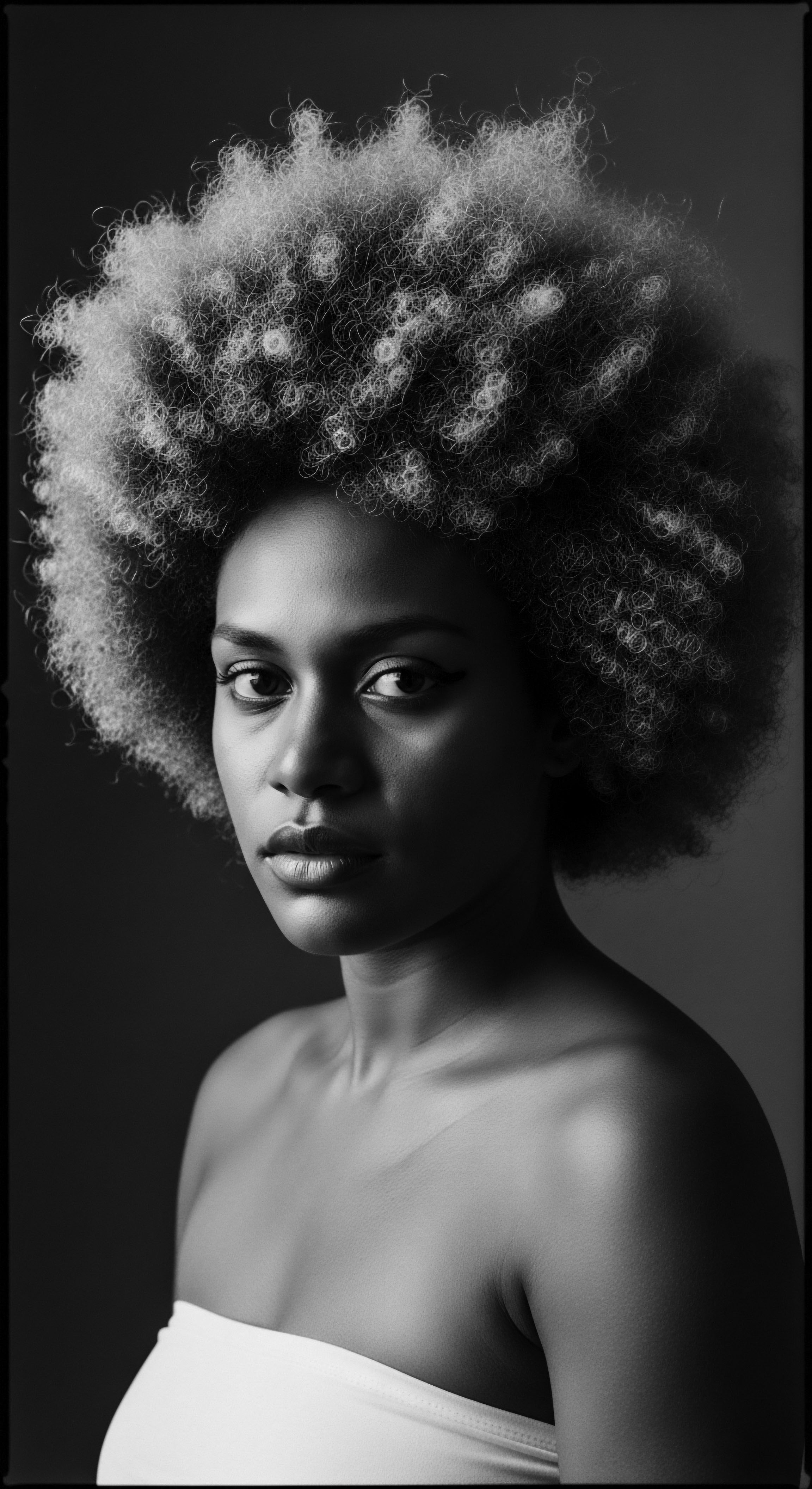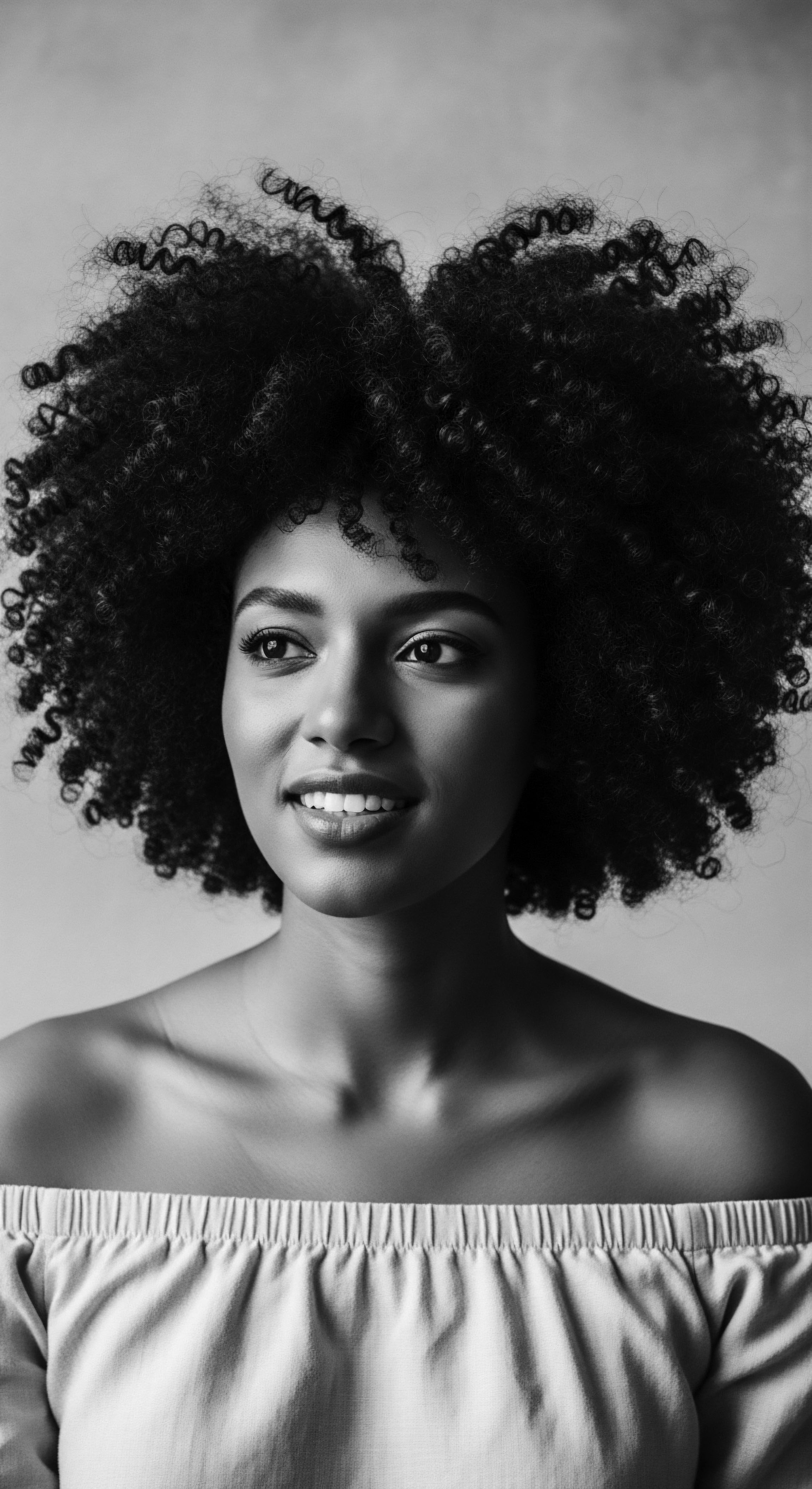
Fundamentals
The story of Murumuru Butter Use begins in the vast, verdant expanse of the Amazon rainforest, a biome pulsating with a life force that has sustained communities for millennia. This remarkable botanical offering, derived from the seeds of the Astrocaryum Murumuru Palm, presents itself as a testament to nature’s profound generosity. For those newly acquainting themselves with this treasure, its most straightforward explanation centers on its physical and functional attributes.
Murumuru butter manifests as a solid, creamy substance at ambient temperatures, possessing a distinct melting point that allows it to yield readily to the warmth of the skin. This characteristic makes it eminently suitable for cosmetic applications, particularly within the domain of hair care.
At its elemental composition, Murumuru butter is a storehouse of valuable fatty acids. It holds a significant proportion of Lauric Acid and Myristic Acid, alongside oleic acid, which collectively contribute to its deep emollient capacities. When applied, these constituents interact with the hair shaft, imparting a perceptible sense of moisture and a tactile smoothness. The butter’s inherent properties make it a natural choice for enhancing the appearance and feel of various hair types, particularly those that thirst for hydration.
In the context of hair, the purpose of Murumuru butter is clear ❉ it serves as a robust sealant, helping to diminish moisture escape from the hair cuticle. This action leaves hair feeling soft, exhibiting a natural sheen, and possessing increased pliability. Its utility has broadened from its original, indigenous applications to become a valued element in modern hair care formulations, recognized for its conditioning capabilities. The transition from its wild origins to our contemporary understanding reflects a continuum of recognition for nature’s gifts.
Murumuru butter, a gift from the Amazon, offers a natural pathway to enhanced hair moisture and softness, a quality recognized through generations.
The initial designation of Murumuru butter as a hair care agent stems from its palpable effect on dryness and its capacity to smooth the hair’s external layer. It offers a protective veil, particularly beneficial for hair exposed to environmental elements or subjected to various styling routines. This botanical fat, with its simple yet powerful structure, offers an accessible and effective method for improving hair’s overall condition. The core principle of its effectiveness lies in its inherent fatty acid profile, which aligns beautifully with the basic needs of hair fibers for sustained hydration and structural support.

Intermediate
Moving beyond the foundational characteristics, the intermediate discourse surrounding Murumuru Butter Use invites a closer examination of its nuanced interaction with the diverse architecture of hair, particularly textured strands. Here, the significance of its unique fatty acid profile gains deeper import. The dominance of Lauric Acid, a medium-chain fatty acid, is noteworthy for its capacity to enter the hair shaft, a distinction not shared by all emollients. This ability grants Murumuru butter a role beyond superficial coating; it participates in an internal process of hair reinforcement and moisture replenishment.
For textured hair, encompassing the rich spectrum of waves, curls, and coils, the open cuticular scales, a common feature, often result in increased porosity and susceptibility to moisture loss. Murumuru butter, with its affinity for the hair fiber, contributes to sealing these cuticular layers. This forms a natural, breathable barrier that helps to reduce evaporative water loss.
The butter’s presence on the hair shaft diminishes friction, consequently leading to less breakage and improved manageability. This mechanical advantage is a direct outcome of its conditioning properties, which render individual strands more supple and less prone to tangling.
The traditional knowledge surrounding plant-based care, from which Murumuru butter’s modern appreciation stems, intuitively grasped these benefits through observation and generational wisdom. Ancestral communities, living in close communion with their environments, discerned the restorative capacities of local flora. Their practices, honed over centuries, represent an applied science, a living laboratory where the efficacy of ingredients like Murumuru was empirically verified through consistent application and shared communal results. This represents a continuum where traditional understandings laid groundwork for contemporary insights.
To further illustrate its distinctive qualities, a comparison with other natural emollients clarifies Murumuru butter’s particular advantages for textured hair:
| Natural Butter Murumuru Butter |
| Primary Traditional Hair Use Protection from environmental elements, moisture retention |
| Key Benefit for Textured Hair (Intermediate) Lauric acid's ability to enter the hair shaft, sealing cuticle and reducing friction |
| Natural Butter Shea Butter |
| Primary Traditional Hair Use General conditioning, scalp health, sun protection |
| Key Benefit for Textured Hair (Intermediate) Forms a strong protective barrier, softens strands, aids in managing frizz |
| Natural Butter Cocoa Butter |
| Primary Traditional Hair Use Strengthening, adding weight to hair |
| Key Benefit for Textured Hair (Intermediate) Adds density, moisture, and aids in maintaining elasticity for thicker textures |
| Natural Butter Cupuaçu Butter |
| Primary Traditional Hair Use High water absorption, emollient qualities |
| Key Benefit for Textured Hair (Intermediate) Exceptional water-holding capacity, provides intense hydration for parched strands |
| Natural Butter These natural butters, all rooted in ancestral use, demonstrate diverse, yet complementary, approaches to nurturing textured hair, each offering specific contributions from nature's bounty. |
The application of Murumuru butter extends beyond mere conditioning; it becomes an active agent in hair health, contributing to the hair’s flexibility and reducing the incidence of breakage associated with styling and manipulation. The significance of this butter, therefore, lies in its capacity to fortify the hair’s structural integrity while also enhancing its external appearance. Its specific fat composition allows for a less greasy feel compared to some other heavier butters, making it versatile for different hair porosity levels and densities within the textured hair community.

Academic

The Heritage of Murumuru Butter Use ❉ An Ethnobotanical and Cultural Cartography
The academic understanding of Murumuru Butter Use extends a definitional hand beyond its mere chemical composition or functional properties to encompass its profound cultural, historical, and ethnobotanical significance, particularly within the context of textured hair heritage. It is not simply a cosmetic ingredient; it is a vital expression of long-standing human-plant relationships, a testament to ancestral ingenuity, and a tangible link to biocultural diversity. This meaning is rooted in the very origins of the Astrocaryum murumuru palm within the Amazon basin, a region where traditional communities have for centuries cultivated an intimate knowledge of their botanical surroundings.
The explication of Murumuru Butter Use, from this academic vantage point, necessitates a deep dive into the co-evolution of human communities and the natural world. Indigenous populations across the Amazon recognized the palm’s value, not solely for its cosmetic attributes, but as an integral part of their daily existence, providing food, shelter, and materials for craft. The observation of its seeds yielding a restorative oil would have been a discovery born of sustained interaction and empirical understanding, passed down orally and through practice across generations. This ancient wisdom, often intertwined with spiritual and communal rituals, laid the groundwork for its continued application in hair and skin care.
The story of Murumuru butter is a chronicle of deep connection between ancestral communities and the Amazonian ecosystem, a profound repository of traditional ecological knowledge.
The meaning of Murumuru Butter Use gains further layers of complexity when examining its interconnected incidences with Afro-diasporic experiences, particularly in Brazil. The historical narrative of enslaved Africans and their descendants, who formed Quilombola communities, speaks to an extraordinary process of cultural adaptation and survival. Arriving in a new land, stripped of many familiar traditions and resources, these communities demonstrated immense resilience by integrating elements of indigenous knowledge with their inherited African hair care customs. This blending created unique, syncretic practices, often relying on the rich local flora to maintain hair health and, critically, to preserve identity.

A Legacy of Resilience ❉ Murumuru Butter in Quilombola Hair Traditions
The enduring wisdom of ancestral approaches to natural resources finds remarkable affirmation in the contemporary scientific comprehension of Murumuru butter. This continuous thread of hair understanding is particularly vivid in the practices of Quilombola communities in Brazil. These communities, forged by the descendants of freedom-seeking enslaved Africans, represent powerful examples of cultural persistence and adaptation. Their interaction with the Amazonian environment led to the incorporation of native plants, including the Murumuru palm, into their daily lives and traditional health and beauty regimens.
Research on the ethnobotanical practices of these communities highlights how local flora became indispensable for their self-sufficiency and the continuity of their cultural heritage (de Paula Filho et al. 2021).
For Quilombola people, hair was not merely an aesthetic feature; it served as a vital cultural marker, a symbol of origin, status, and resistance, echoing the deep spiritual and communal meanings of hair in various African societies (Byrd & Tharps, 2014). The traumatic experience of enslavement often involved the forcible shaving or alteration of hair, aiming to strip individuals of their identity. In response, maintaining hair, even with adapted resources, became an act of defiance, a quiet claim to selfhood. The adoption of Amazonian botanical resources, like Murumuru butter, for hair conditioning, protection, and styling, speaks to this ingenious synthesis of inherited African knowledge with newly acquired environmental wisdom.
Consider, for instance, the Quilombo da Fazenda community in Ubatuba, São Paulo, and other Quilombola groups whose knowledge of local vegetation, including plants with cosmetic and medicinal properties, has been meticulously recorded (Sauini et al. 2023). While specific documentation detailing Murumuru butter use for hair in these specific communities might be nascent in widely accessible academic literature, the broader pattern of traditional communities employing forest resources for health and beauty is well-established. The very act of harvesting and processing such ingredients, often through communal effort, also reinforced social bonds and sustained traditional ecological knowledge systems, thus maintaining a collective memory and shared cultural identity (da Silva et al.
2020). This continuous practice serves as an unwritten archive of resilience.

From Elemental Biology to Embodied Identity ❉ The Scientific Affirmation
The scientific analysis of Murumuru butter’s composition provides a contemporary validation of these ancestral practices. Its high concentration of Lauric Acid (approximately 40-50%), a fatty acid similar to those found naturally in hair, allows for its particular efficacy. This fatty acid can penetrate the hair cuticle, offering true conditioning from within, as opposed to merely sitting on the surface.
This chemical property translates into tangible benefits for highly textured hair, which, due to its unique helical structure and frequent coiling, tends to be more prone to dryness and breakage. The butter’s ability to reduce protein loss during washing and to provide a protective layer makes it a potent ally for maintaining the structural integrity of textured strands.
The historical application of Murumuru butter within Indigenous and Afro-Brazilian communities, therefore, transcends anecdotal wisdom. It finds resonance in modern trichology, which recognizes the specific molecular interactions that contribute to hair health. The butter’s inherent emollient properties provide a lubricious coating that reduces the friction between hair strands, a significant factor in preventing mechanical damage during combing or styling.
This attribute would have been instinctively understood by those who relied on these natural ingredients to detangle and manage complex hair textures, ensuring that hair could be adorned, styled, and maintained without undue stress. The long-term consequences of such practices extend beyond individual hair health, contributing to the communal well-being and reaffirmation of cultural heritage.
The continued presence of Murumuru butter in contemporary natural hair movements is not merely a trend; it represents a re-connection to a heritage of plant-based care and a rejection of beauty paradigms that historically marginalized textured hair. Its use today signifies a reclamation of ancestral wisdom, acknowledging that the solutions for hair health often lie within the natural world, a knowledge preserved and passed down by those who lived closest to the source. The deliberate choice to incorporate ingredients like Murumuru butter into modern routines is an act of honoring lineage, recognizing the profound connections between the past, present, and future of textured hair care.
This re-evaluation of Murumuru Butter Use, through an academic lens deeply conscious of heritage, highlights several crucial aspects:
- Biocultural Knowledge Systems ❉ The long-standing use of Murumuru butter by Amazonian indigenous groups and subsequently by Afro-diasporic communities represents sophisticated biocultural knowledge, where environmental understanding and practical application are intertwined with cultural identity and survival.
- Hair as a Cultural Repository ❉ The application of Murumuru butter to textured hair serves as a tangible practice that preserves and transmits cultural knowledge, offering a pathway to connect with ancestral traditions that recognized hair as a sacred component of self.
- Ethical Sourcing and Sustainability ❉ Modern commercial interest in Murumuru butter brings with it a responsibility to acknowledge its origins and to ensure that harvesting practices continue to respect the ecological balance of the Amazon and provide equitable benefits to the traditional communities who are the original custodians of this knowledge.
- Reclaiming Narratives ❉ The choice to foreground ingredients like Murumuru butter in contemporary hair care allows for a narrative shift, celebrating the unique qualities of textured hair and challenging the historical imposition of Western beauty ideals.
The enduring value of Murumuru Butter Use, therefore, lies not just in its chemical efficacy but in its capacity to carry forward a story of resilience, adaptation, and profound reverence for the earth’s offerings, serving as a powerful emblem of textured hair heritage. The academic scrutiny of this butter opens channels for understanding the intricate relationship between ecological stewardship, cultural continuity, and individual identity, particularly for those whose hair carries generations of history within each strand.

Reflection on the Heritage of Murumuru Butter Use
The journey through the explanation and significance of Murumuru Butter Use reveals a profound truth ❉ our hair, in all its varied textures, holds within it the whispers of generations past. The very act of applying a butter derived from the Amazonian palm to a coily or kinky strand is more than a simple act of conditioning; it becomes a dialogue with ancestral practices, a re-membering of elemental wisdom. This butter, born of the earth’s generosity, carried across oceans of time and experience, represents a living archive. Its enduring presence in the routines of Black and mixed-race hair care speaks volumes about resilience, about the innate human capacity to find sustenance and beauty even in the face of profound upheaval.
The lineage of care, from the hands of indigenous Amazonians tending to their strands to the adaptive brilliance of Quilombola communities finding solace and identity in nature’s bounty, continues to inform our contemporary appreciation. It reminds us that knowledge is often embodied, passed down through touch, through communal rituals, and through the very ingredients that nourish us. The tender thread of Murumuru Butter Use, therefore, ties us not only to a plant but to a vast, intricate web of human history, cultural preservation, and self-acceptance.
As we honor this legacy, we are invited to consider our own relationship with our hair – not as something to be tamed or altered, but as a sacred extension of our being, deserving of reverence and mindful care. The continued reverence for Murumuru butter in textured hair care is a powerful testament to the timeless wisdom that resides in natural solutions and the unbroken spirit of those who nurtured it across generations. It suggests a future where hair care is not just about appearance, but about deep connection to one’s roots, a celebration of the extraordinary heritage inscribed in every curl, every wave, every coil. It is, truly, the Soul of a Strand, made manifest.

References
- Byrd, A. D. & Tharps, L. D. (2014). Hair Story ❉ Untangling the Roots of Black Hair in America. St. Martin’s Press.
- da Silva, S. T. do Nascimento Junior, J. B. Mendes, F. N. & Silva, J. B. (2020). Ethnobotanical Surveys of Plants Used by Quilombola Communities in Brazil ❉ A Scoping Review. Forests, 11(10), 1032.
- de Paula Filho, F. J. P. Sales, B. C. P. Sousa, L. M. Siqueira, P. B. Rangel, H. R. & Siqueira, K. M. (2021). Ethnobotanical Knowledge on Non-conventional Food and Medicinal Plants in Rio Cajari Extractivist Reserve, Amazon, Brazil. Boletín Latinoamericano y del Caribe de Plantas Medicinales y Aromáticas, 20(5), 647-662.
- Sauini, T. Leite, S. D. & Mendes, T. C. (2023). Quilombola communities reveal the use of plants. Revista Fapesp, 335.
